Instrument care is often neglected during lesson time for beginners. Here, Iris Zhulla from the Women in Lutherie community shares some tips to aid beginners and their parents

Discover more lutherie articles here
I started learning violin when I was six years old and sadly I ’tortured’ some instruments and bows in the process. Now in my workshop, as well as making and restoring instruments for professionals, I prepare and set up instruments for beginners and students. Before they leave with their new violin, viola or cello, I make sure to give them some advice and tips to help them learn the first steps on how to take care of their instrument.
Here are some basic good habits to instill:
-
Always loosen your bow hair when not practising. To do that, you have to turn the screw of the bow anti-clockwise. Do that until you see the hair loosen up but not too much so the hair doesn’t get tangled inside the case. In order to play you will have to turn the screw clockwise just until a pencil can easily fit in the tightest area between the hair and the stick. Careful to not overtighten the bow!
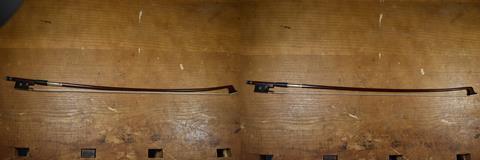
-
Wipe clean your strings, instrument and bow (with the help of a parent for very young children). Take a clean microfibre cloth and wipe all the fresh rosin dust on the strings close to the bridge and the area under the bridge. Be careful to not knock around the bridge. Clean the rest of the fingerboard and the rest of the instrument with a cleaner rosin-free cloth. For the bow, pass the cloth between the hair and the stick and wipe the stick only.
-
Put the instrument in its case after use - not on a couch, bed or a chair. Secure both instrument and bow with the clips and bands of the case and don’t stop until the zipper around the case is all zipped up - many accidents happen because the case appeared closed but actually wasn’t. For a cello, put the instrument inside the soft case first and then the bow to avoid damage of the bow. When putting away the cello in its soft case, make sure it is not standing but the instrument is resting on its side. Never place an instrument case with the bridge facing down.
-
Change your violin strings every six to twelve months and cello strings every ten to sixteen months (or sooner if damage is evident). It’s best to take your instrument to a luthier where they can put everything back in its place - this may included a bridge or soundpost knocked out of place. For those interested in learning how to change the strings by yourself, the two most important tips I can give you are to never take off the old strings simultaneously but change them one by one and to learn how to pull your bridge top back in its place so it sits up straight and it doesn’t warp. (your local luthier can show you the process and with some practise you can learn how to change the strings on your or your child’s instrument by yourself).
Read: Looking after your instrument: a beginner’s guide on how to change your strings
Read: Tips for changing your violin strings
Discover more lutherie articles here
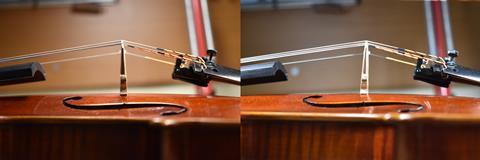
Left: after changing the strings and tuning, the bridge has leaned towards the fingerboard
Right: the correct posture of the bridge, where the back of the bridge is perpendicular to the instrument
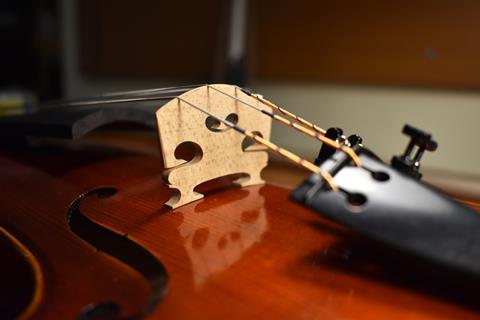
-
Take your bow for a rehair at least once every school year, or sooner if damage is evident. Signs of damage include a lot of hairs missing, as well as grease on the hairs that make bowing feel slippery. When the hair is too old and doesn’t ’grab’ the strings we tend to put more pressure with our right arm and play tightly. That is not something we want to encourage in a student.
Here are some dos and don’ts to help you keep your instrument in good health:
-
Don’t touch the hair of the bow with your hands or anything that could be oily, wet or dirty.
-
When some bow hairs break, don’t pull them out, cut them with a nail clipper close to the two ends of the bow. Pulling the hair could cause a bunch of hair to come out all at once.
-
Don’t expose your instrument in extreme temperatures and humidity levels or extreme and fast changes of them. Don’t place the instrument in the trunk of a vehicle especially in hot summers and cold winters; next to the radiator, directly under the cold air of an air conditioner, under direct sunlight for hours, or in basements and balconies. Be careful when you use a dehumidifier at home to not overdo it - normal conditions should be approximately a temperature around 18°C - 25°C (65F – 75F) and humidity at 40-60 per cent. Anything higher or lower can still work as long as the change of the temperature or humidity is not sudden and not for extended periods of time. When you take your instrument somewhere with a change of conditions, wait 15 minutes before you open the case to give the instrument time to acclimatise.
-
Don’t touch any part of your instrument or bow with wet hands. If you sweat a lot, wipe the instrument dry after practising. A drop of water can bend and warp your bridge in no time and elongate your bow hair.
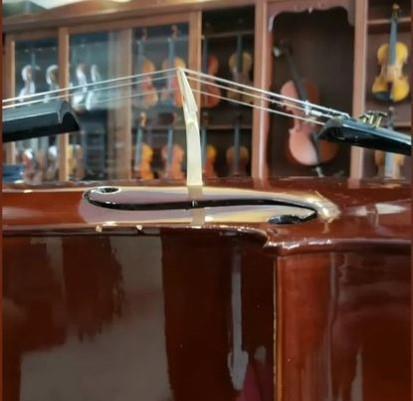
Read: Looking after your instrument: Fingerboards demystified
Read: Looking after your instrument: a guide on caring for your bow
Discover more lutherie articles here
-
Don’t hang your violin on the stand or leave your bow on the stand
-
Don’t leave your violin on a chair during rehearsal breaks
-
Don’t tap your bow on the stand as an alternative to applauding
-
If a peg gets stuck, don’t use pliers to turn it!
-
Always secure the screw of the cello endpin to avoid accidents.
Make sure to always listen and look at your instrument. Look out for open seems and any parts that don’t seem glued properly, missing varnish, weird buzzes, sound that has changed dramatically or difficulty in pressing down the strings. In general, I would suggest to take the instrument for a check up every six months, in order to prevent damage. That way you can make sure you and your child are learning correctly with an instrument that has everything in the right place.
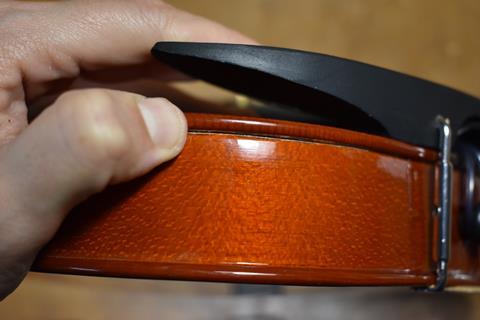
All photos courtesy of Iris Zhulla
Iris Zhulla is a violin maker based in Thessaloniki, Greece.
Read: Looking after your instrument: an introduction to soundposts
Read: Looking after your instrument: a guide to cleaning and polishing
Listen: The Strad Podcast Episode #47: Korinthia Klein on basic instrument maintenance
Discover more lutherie articles here



































No comments yet